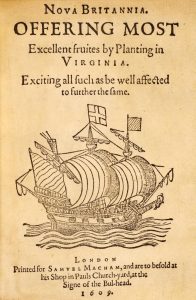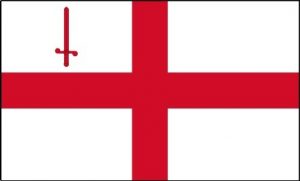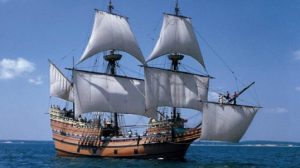Flags of the Mayflower
John M. Hartvigsen
Flags add a dramatic touch to drawings and paintings of historic events, and sailing ships are usually depicted under full sail with flags flying. Since flags at sea had the primary task of identification, ships flew their flags only when needed for that purpose. Flags become tattered and torn in wind and weather, so why expose them to the elements if other ships were not present not see them?
Each year around Thanksgiving thoughts turn to the Pilgrims of Plymouth in Massachusetts. What flags did they display during their voyage aboard the Mayflower? The ship would have flown flags in English waters upon embarkation, but at sea when they encountered no other shipping the flags would have remained in the flag locker, and upon arrival in the waters off Cape Cod the display of flags would not have been recognized or understood by members of the Wampanoag tribe watching in hiding from the shore. So, in all likelihood the Pilgrims saw little of flags flying from Mayflower’s rigging.
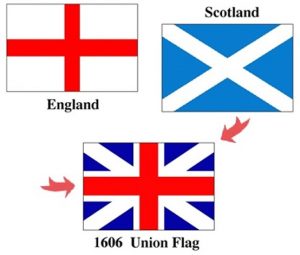 Historically, there were two flags English ships flew in 1620. The English Cross of St. George and the Union Flag of 1606. More about these two flags can be found in another Flag-Post article at the link: http://flag-post.com/the-flag-of-saint-george-and-england/.
Historically, there were two flags English ships flew in 1620. The English Cross of St. George and the Union Flag of 1606. More about these two flags can be found in another Flag-Post article at the link: http://flag-post.com/the-flag-of-saint-george-and-england/.
As the ship was sent by the London Company, a third flag may have been flown by the Mayflower, the flag of London. The voyage of the Mayflower and the settlement of the Pilgrims in Nova Britannia, a Latin name for the planned colony, was funded by the Virginia London Company. The replica of the Mayflower flies the flag of the City of London from the mizzen mast.
The Flag of the City of London adds a red sword to the upper quarter of the flag nearest to the haulyard. Said to symbolize the sword used to behead St. Paul, the emblem acknowledges St. Paul as the patron saint of the City of London. The square mile at the center of Greater London is historically known as the City of London, which is often shortened simply to the City. Chartered by King James I, the London Company sponsored settlement in Jamestown and Plymouth between 1606 and 1624. A joint-stock company, the London Company was separate from the London City’s corporation that governs the area that today is the business district at the center of greater London. The flag of the City of London is flown on the mizzen mast of the Mayflower’s replica, which is at anchor in Plymouth, Massachusetts.
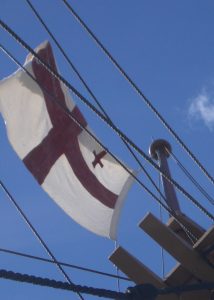
Flag of the City of London flying from the mizzen mast of the Mayflower’s replica moored in Plymouth, Massachusetts.
A typical 17th Century ship, the square rigger Mayflower boasted three masts: the mizzen mast found closest to the stern, the mainmast at midship and the foremast closest to the bow. When Mayflower flew flags in British Water, it would likely have flown the Union Jack at the mainmast and the Cross of St. George at the foremast. If the flag of the City of London flew, it would have been at the mizzen mast. Today’s replica often flies St. George’s Cross on both the foremast and the mainmast, and that would have often been done once a vessel left British Waters.
These three flags not only accompanied Massachusetts settlers in Plymouth and earlier settlers Jamestown, Virginia—on land and sea, they became the first of a long line of flags telling the history of the United States. Its red and white colors are part of the Stars and Stripes flow today over states that began as the British North American Colonies. A Flag-Post article tells the story of how the Cross of St. George and the Union Jack evolved into the United States flag. It can be found at the link: http://flag-post.com/flags-may-have-inspired-the-american-union/.

